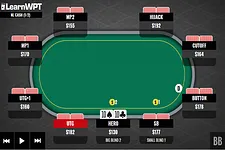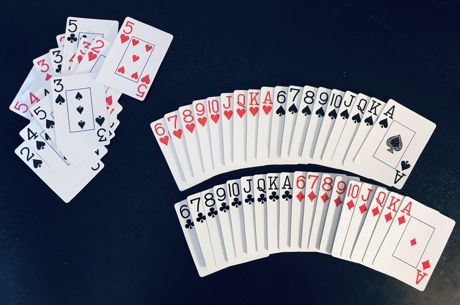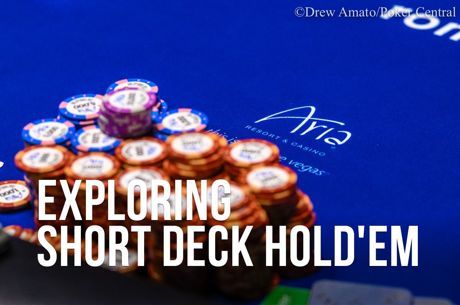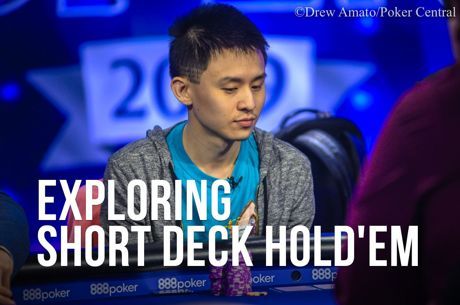Exploring Short Deck Hold'em, Part 5: Postflop Play Continued

Table Of Contents
Last week, we got into the "chess" segment of short deck hold'em, examining some of the principles that should guide postflop play in this high-action, increasingly popular format.
The Run It Up patriarch himself, Jason Somerville, shared his thoughts on ranging opponents and operating in multi-way pots in Part 4 of this series.
Somerville had plenty of further thoughts to share about postflop strategy in short deck (or "six plus") hold'em, including topics like bet sizing, using blockers, and what sort of play best prepares someone to tackle short deck.
Bet Sizing
Sizing your bets is an integral part of poker, both for getting maximum value and forcing folds from hands that may be better or have decent equity.
Short deck is no different, but one of the things that changes in a big way is typical sizing.
In regular hold'em, a popular line in the current meta is to bet on the smaller side on the flop, sometimes as small as 20 or 30 percent of the pot on some textures. Then, players will follow up with much bigger bets closer to the size of the pot on the turn and/or river.
That sort of line doesn't play as much of a role in short deck, Somerville explains. Instead, players frequently size much bigger, including shoves for over the size of the pot.
"Full-pot bets and overbets are more common," Somerville says. "Denying equity is more important. Getting people to incorrectly fold their equity is great."
If you contrast two typical situations, it should be obvious why small bets can work wonders in hold'em but aren't so helpful in short deck.
Take AxKx against J♣10♣ on 9♦8♠A♥. In hold'em, a bet of half the size of the pot — giving the opponent 3-to-1 odds — makes it incorrect to call with J♣10♣ unless you are sure you'll win more money down the line, as it's nearly 5-to-1 against making the hand on the turn.
But in short deck, J♣10♣ is getting correct immediate odds to call even if not another penny goes in the pot, since there is a 26 percent chance of filling the straight on the turn.
For this reason, bigger is generally better in short deck. Somerville says smaller bets can play a role against inexperienced foes but won't work against opponent who understands some of the math behind the game.
"Against more sophisticated players, they'll realize that [when facing] smaller bets, they should probably just call," he says.
Representing Hands and Bluffing
Attempting to read opponents' hands in short deck can be a little akin to playing pot-limit Omaha — more on that later — in that it can be easy to find monsters under the bed, so to speak. That is to say, turns and rivers will frequently change what hand is the nuts, so it can be easy to get gun-shy and go into shutdown mode.
"There are tons of bluffing opportunities in this game, more so than full deck," Somerville points out.
Somerville says position, having the betting lead, and blockers are all still factors when it comes to bluffing, although there may be additional nuances here and there to consider.
For example, take a hold'em situation that involves a fairly dead board featuring a flush draw. A player with the betting lead who is out of position will frequently check if a card that potentially completes a flush arrives on the board in hold'em or Omaha.
In short deck, that's not so much the case, because there are far fewer flushes made due to the lower number of cards in each suit available in the shortened (36-card) deck.

"It's hard to represent flushes because flushes are hard to make," Somerville says. "In a heads-up pot you have to say, 'Is my opponent the kind of player who would believe I have a flush here?'"
Straights, on the other hand, are quite plentiful in short deck. However, because the board will very often feature possible straights, it's important not to go crazy and be tempted to try to blow your opponent off of his or her hand any time a card that completes possible straights hits the felt.
"You can't be over-bluffing in these spots," Somerville says. "Think about the history between you and your opponent, what kinds of hands have been shown down. Does this create a good situation for you to be bluffing?"
Blockers have become an important part of game theory in other games, and Somerville says that "absolutely" holds in short deck.
"If you have 10x10x in a spot where a ten is a critical card to make a straight, and that's all you have, you have a very good bluffing opportunity," Somerville says. "Any time you have information that your opponents don't have, you're certainly incentivized to bluff."
That includes having position and seeing an opponent's action in front. Betting in position, Somerville explains, is still a "very powerful tool."
PLO Players' Paradise?
If a lot of the above advice — sizing bets bigger in a lot of spots, leveraging position frequently, and (especially) the importance of blockers — sounds like it applies to pot-limit Omaha as well, that's probably because it does.
"It's very similar to PLO in many ways," Somerville says. "When you look at some of the guys who put their brains into it, a lot of them are excellent PLO players. It feels like PLO in terms of bluffing frequency and how you construct your decisions in a lot of spots."
Just like PLO, short deck is a very complex game postflop that gets much deeper in terms of layers of thinking required when compared to heads-up hold'em pots. Both games feature tons of action and multi-way pots that make decisions tricky, and that's why Somerville has enjoyed trying to work out correct strategy in the early stages of short deck's life.
"The game tree is much deeper postflop," he says. "It's a beautiful game, really. A lot going on."
In this Series
- 1 Short Deck Poker Rules: How to Play Short Deck Poker
- 2 Exploring Short Deck Hold'em, Part 2: Odds and Probabilities
- 3 Exploring Short Deck Hold'em, Part 3: Preflop Play
- 4 Exploring Short Deck Hold'em, Part 4: Postflop Play
- 5 Exploring Short Deck Hold'em, Part 5: Postflop Play Continued
- 6 Exploring Short Deck Hold'em, Part 6: Hand Review - Bonomo Bluffs
- 7 Exploring Short Deck Hold'em, Part 7: Hand Review - Ivey Shoves Big
- 8 Exploring Short Deck Hold'em, Part 8: Hand Review - Koon Uses Blockers
- 9 Exploring Short Deck Hold'em, Part 9: Hand Review - Yu Finds a Fold
- 10 Exploring Short Deck Hold'em, Part 10: Tournaments and the Future










